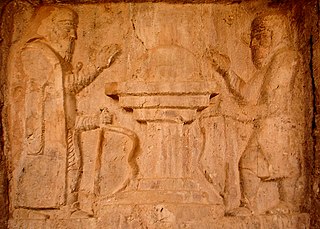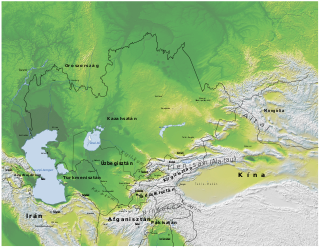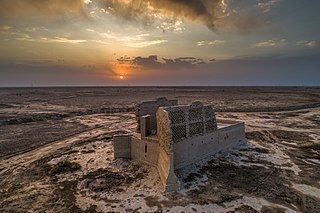
The Medes were an ancient Iranian people who spoke the Median language and who inhabited an area known as Media between western and northern Iran. Around the 11th century BC, they occupied the mountainous region of northwestern Iran and the northeastern and eastern region of Mesopotamia located in the region of Hamadan (Ecbatana). Their consolidation in Iran is believed to have occurred during the 8th century BC. In the 7th century BC, all of western Iran and some other territories were under Median rule, but their precise geographic extent remains unknown.

The Saka, Shaka, or Sacae were a group of nomadic Eastern Iranian peoples who historically inhabited the northern and eastern Eurasian Steppe and the Tarim Basin.

The Thracians were an Indo-European speaking people who inhabited large parts of Southeast Europe in ancient history. Thracians resided mainly in Southeast Europe in modern-day Bulgaria, Romania and northern Greece, but also in north-western Anatolia in Turkey.

The Agathyrsi were a people belonging to the Scythian cultures who lived in the Transylvanian Plateau, in the region that later became Dacia.

Cyaxares was the third king of the Medes.

Arachosia, or Harauvatis, was a satrapy of the Achaemenid Empire. Primarily centred around the Arghandab River, a tributary of the Helmand River, it extended as far east as the Indus River. The satrapy's Persian-language name is the etymological equivalent of Sárasvatī in Vedic Sanskrit. In Greek, the satrapy's name was derived from Arachōtós, the Greek-language name for the Arghandab River. Around 330 BCE, Alexander the Great commissioned the building of Alexandropolis as Arachosia's new capital city under the Macedonian Empire. It was built on top of an earlier Persian military fortress after Alexander's conquest of Persia, and is the site of today's Kandahar in Afghanistan.

The Scythian languages are a group of Eastern Iranic languages of the classical and late antique period, spoken in a vast region of Eurasia by the populations belonging to the Scythian cultures and their descendants. The dominant ethnic groups among the Scythian-speakers were nomadic pastoralists of Central Asia and the Pontic–Caspian steppe. Fragments of their speech known from inscriptions and words quoted in ancient authors as well as analysis of their names indicate that it was an Indo-European language, more specifically from the Iranic group of Indo-Iranic languages.

The Massagetae or Massageteans, also known as Sakā tigraxaudā or Orthocorybantians were an ancient Eastern Iranian Saka people who inhabited the steppes of Central Asia and were part of the wider Scythian cultures. The Massagetae rose to power in the 8th to 7th centuries BCE, when they kickstarted a series of events with wide-reaching consequences by expelling the Scythians out of Central Asia and into the Caucasian and Pontic Steppes. The Massagetae are most famous for their queen Tomyris's alleged defeating and killing of Cyrus, the founder of the Persian Achaemenid Empire.

Tomyris also called Thomyris, Tomris, or Tomiride, reigned over the Massagetae, an Iranian Saka people of Central Asia. Tomyris led her armies to defend against an attack by Cyrus the Great of the Achaemenid Empire, and, according to Herodotus, defeated and killed him in 530 BC.
The Iranian languages, also called Iranic languages, are a branch of the Indo-Iranian languages in the Indo-European language family that are spoken natively by the Iranian peoples, predominantly in the Iranian Plateau.

Media is a region of north-western Iran, best known for having been the political and cultural base of the Medes. During the Achaemenid period, it comprised present-day Azerbaijan, Iranian Kurdistan and western Tabaristan. As a satrapy under Achaemenid rule, it would eventually encompass a wider region, stretching to southern Dagestan in the north. However, after the wars of Alexander the Great, the northern parts were separated due to the Partition of Babylon and became known as Atropatene, while the remaining region became known as Lesser Media.

Saka, or Sakan, was a variety of Eastern Iranian languages, attested from the ancient Buddhist kingdoms of Khotan, Kashgar and Tumshuq in the Tarim Basin, in what is now southern Xinjiang, China. It is a Middle Iranian language. The two kingdoms differed in dialect, their speech known as Khotanese and Tumshuqese.

The Eastern Iranian languages are a subgroup of the Iranian languages, having emerged during the Middle Iranian era. The Avestan language is often classified as early Eastern Iranian. As opposed to the Middle-era Western Iranian dialects, the Middle-era Eastern Iranian dialects preserve word-final syllables.

Sistān, known in ancient times as Sakastān, is a historical and geographical region in present-day Eastern Iran and Southern Afghanistan. Largely desert, the region is bisected by the Helmand River, the largest river in Afghanistan, which empties into the Hamun Lake that forms part of the border between the two countries.

Skudra was a province (satrapy) of the Persian Achaemenid Empire in Europe between 510s BC and 479 BC. Its name is attested in Persian and Egyptian inscriptions (an Egyptian record of c. 498–497 BC, and a list on the tomb of Darius the Great at Naqsh-e Rustam, c. 486 BC. It is believed to have comprised the lands now known as Thrace and Macedon.

The Amyrgians were a Saka tribe.

Spargapises was the son of queen Tomyris of the Massagetai.

The Scythian campaign of Darius I was a military expedition into parts of European Scythia by Darius I, the king of the Achaemenid Empire, in 513 BC. The Scythians were an East Iranian-speaking people who had invaded Media, revolted against Darius and threatened to disrupt trade between Central Asia and the shores of the Black Sea as they lived between the Danube and Don Rivers and the Black Sea. The campaigns took place in parts of what is now the Balkans, Ukraine, and southern Russia.
The names of the Scythians are a topic of interest for classicists and linguists. The Scythians were an Iranic people best known for dominating much of the Pontic steppe from about 700 BC to 400 BC. The name of the Scythians is believed to be of Indo-European origin and to have meant "archer". The Scythians gave their name to the region of Scythia. The Persians referred to all Iranian nomads of the steppes, including the Scythians, as Sakas. Some modern scholars apply the name Scythians to all peoples of the Scytho-Siberian world, but this terminology is controversial.















